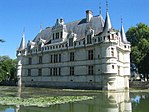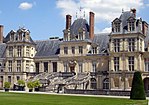
Back عمارة النهضة الفرنسية Arabic Fransız İntibah memarlığı Azerbaijani Arquitectura renaixentista francesa Catalan Arquitectura renacentista francesa Spanish Վերածննդի դարաշրջանի ֆրանսիական ճարտարապետություն Armenian Architektura renesansu we Francji Polish Arquitetura renascentista francesa Portuguese Французская архитектура эпохи Возрождения Russian Francoska renesančna arhitektura Slovenian Француска ренесансна архитектура Serbian
Top: Château de Chambord; Château de Chenonceau: Center: Azay le Rideau; Château de Fontainebleau; Bottom: Lescot Wing of Louvre | |
| Years active | Late 15th – early 17th centuries |
|---|---|
French Renaissance architecture is a style which was prominent between the late 15th and early 17th centuries in the Kingdom of France. It succeeded French Gothic architecture. The style was originally imported from Italy after the Hundred Years' War by the French kings Charles VII, Louis XI, Charles VIII, Louis XII and François I. Several notable royal châteaux in this style were built in the Loire Valley, notably the Château de Montsoreau, the Château de Langeais, the Château d'Amboise, the Château de Blois, the Château de Gaillon and the Château de Chambord, as well as, closer to Paris, the Château de Fontainebleau.
This style of French architecture had two distinct periods. During the first period, between about 1491 and 1540, the Italian style was copied directly, often by Italian architects and craftsmen. In the second period, between 1540 and the end of the Valois dynasty in 1589, French architects and craftsmen gave the style a more distinctive and original French character.[1]
The major architects of the style included the royal architects Philibert Delorme, Pierre Lescot and Jean Bullant, as well as the Italian architect and architectural theorist Sebastiano Serlio.[2][3]
- ^ Ducher 1988, p. 80.
- ^ Mignon 2017, pp. 193–235.
- ^ Ducher 1988, p. 80–92.
© MMXXIII Rich X Search. We shall prevail. All rights reserved. Rich X Search




